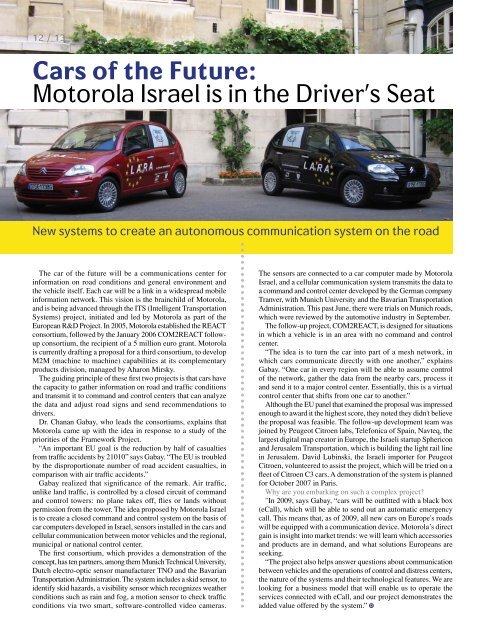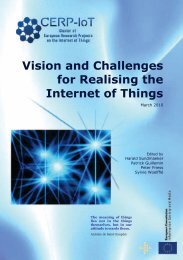Télécharger le document - Eurosfaire
Télécharger le document - Eurosfaire
Télécharger le document - Eurosfaire
Create successful ePaper yourself
Turn your PDF publications into a flip-book with our unique Google optimized e-Paper software.
12 / 13<br />
Cars of the Future:<br />
Motorola Israel is in the Driver's Seat<br />
New systems to create an autonomous communication system on the road<br />
The car of the future will be a communications center for<br />
information on road conditions and general environment and<br />
the vehic<strong>le</strong> itself. Each car will be a link in a widespread mobi<strong>le</strong><br />
information network. This vision is the brainchild of Motorola,<br />
and is being advanced through the ITS (Intelligent Transportation<br />
Systems) project, initiated and <strong>le</strong>d by Motorola as part of the<br />
European R&D Project. In 2005, Motorola established the REACT<br />
consortium, followed by the January 2006 COM2REACT followup<br />
consortium, the recipient of a 5 million euro grant. Motorola<br />
is currently drafting a proposal for a third consortium, to develop<br />
M2M (machine to machine) capabilities at its comp<strong>le</strong>mentary<br />
products division, managed by Aharon Mirsky.<br />
The guiding princip<strong>le</strong> of these first two projects is that cars have<br />
the capacity to gather information on road and traffic conditions<br />
and transmit it to command and control centers that can analyze<br />
the data and adjust road signs and send recommendations to<br />
drivers.<br />
Dr. Chanan Gabay, who <strong>le</strong>ads the consortiums, explains that<br />
Motorola came up with the idea in response to a study of the<br />
priorities of the Framework Project.<br />
“An important EU goal is the reduction by half of casualties<br />
from traffic accidents by 21010” says Gabay. “The EU is troub<strong>le</strong>d<br />
by the disproportionate number of road accident casualties, in<br />
comparison with air traffic accidents.”<br />
Gabay realized that significance of the remark. Air traffic,<br />
unlike land traffic, is control<strong>le</strong>d by a closed circuit of command<br />
and control towers: no plane takes off, flies or lands without<br />
permission from the tower. The idea proposed by Motorola Israel<br />
is to create a closed command and control system on the basis of<br />
car computers developed in Israel, sensors instal<strong>le</strong>d in the cars and<br />
cellular communication between motor vehic<strong>le</strong>s and the regional,<br />
municipal or national control center.<br />
The first consortium, which provides a demonstration of the<br />
concept, has ten partners, among them Munich Technical University,<br />
Dutch e<strong>le</strong>ctro-optic sensor manufacturer TNO and the Bavarian<br />
Transportation Administration. The system includes a skid sensor, to<br />
identify skid hazards, a visibility sensor which recognizes weather<br />
conditions such as rain and fog, a motion sensor to check traffic<br />
conditions via two smart, software-control<strong>le</strong>d video cameras.<br />
The sensors are connected to a car computer made by Motorola<br />
Israel, and a cellular communication system transmits the data to<br />
a command and control center developed by the German company<br />
Tranver, with Munich University and the Bavarian Transportation<br />
Administration. This past June, there were trials on Munich roads,<br />
which were reviewed by the automotive industry in September.<br />
The follow-up project, COM2REACT, is designed for situations<br />
in which a vehic<strong>le</strong> is in an area with no command and control<br />
center.<br />
“The idea is to turn the car into part of a mesh network, in<br />
which cars communicate directly with one another,” explains<br />
Gabay. “One car in every region will be ab<strong>le</strong> to assume control<br />
of the network, gather the data from the nearby cars, process it<br />
and send it to a major control center. Essentially, this is a virtual<br />
control center that shifts from one car to another.”<br />
Although the EU panel that examined the proposal was impressed<br />
enough to award it the highest score, they noted they didn't believe<br />
the proposal was feasib<strong>le</strong>. The follow-up development team was<br />
joined by Peugeot Citroen labs, Te<strong>le</strong>fonica of Spain, Navteq, the<br />
largest digital map creator in Europe, the Israeli startup Sphericon<br />
and Jerusa<strong>le</strong>m Transportation, which is building the light rail line<br />
in Jerusa<strong>le</strong>m. David Lubinski, the Israeli importer for Peugeot<br />
Citroen, volunteered to assist the project, which will be tried on a<br />
f<strong>le</strong>et of Citroen C3 cars. A demonstration of the system is planned<br />
for October 2007 in Paris.<br />
Why are you embarking on such a comp<strong>le</strong>x project?<br />
"In 2009, says Gabay, “cars will be outfitted with a black box<br />
(eCall), which will be ab<strong>le</strong> to send out an automatic emergency<br />
call. This means that, as of 2009, all new cars on Europe's roads<br />
will be equipped with a communication device. Motorola’s direct<br />
gain is insight into market trends: we will <strong>le</strong>arn which accessories<br />
and products are in demand, and what solutions Europeans are<br />
seeking.<br />
“The project also helps answer questions about communication<br />
between vehic<strong>le</strong>s and the operations of control and distress centers,<br />
the nature of the systems and their technological features. We are<br />
looking for a business model that will enab<strong>le</strong> us to operate the<br />
services connected with eCall, and our project demonstrates the<br />
added value offered by the system.”

















